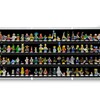Conference Microphones: Enabling Clear Communication in the Modern Meeting Room
In today's fast-paced business and institutional environments, effective communication is non-negotiable. Whether it’s a board meeting, a government hearing, a corporate training session, or an international summit, conference microphone play a crucial role in ensuring that everyone is heard clearly and equally. These specialized microphones are designed not just to capture sound—but to do so with clarity, consistency, and control, even in acoustically challenging spaces.
This article explores the types of conference microphones, their technology, typical applications, and how to choose the right system for your needs.
What Is a Conference Microphone?
A conference microphone is a microphone system specifically designed for use in meetings, seminars, and discussions where multiple people need to communicate clearly. These systems are optimized for speech, often including noise-reduction features, directional pickup patterns, and integration with conferencing or public address (PA) systems.
Unlike standard handheld or studio microphones, conference mics are part of a structured setup—either standalone or integrated into a digital conference system—often with features like push-to-talk buttons, speaker units, voting options, and even camera tracking.
Types of Conference Microphones
1. Wired Conference Microphones
These are the most reliable in terms of signal stability and audio fidelity. Each unit is connected via cables to a central control unit, ensuring consistent power and minimal interference. They are ideal for fixed installations like council chambers or formal meeting rooms.
2. Wireless Conference Microphones
Wireless systems provide freedom of movement and easier installation—particularly useful in multi-purpose rooms or where cabling is impractical. Advanced systems use encrypted transmission to avoid interference and ensure security.
3. Gooseneck Microphones
These are the most recognizable type in conference rooms. They consist of a slim, adjustable neck mounted on a base or built into a desk, allowing directional pickup. Many gooseneck mics are modular and can be paired with push-to-talk or mute buttons.
4. Boundary (Tabletop) Microphones
Often flat and disk-shaped, these microphones are placed directly on the conference table. They capture sound in an omnidirectional or cardioid pattern and are better suited to smaller group settings.
5. Ceiling Array Microphones
These are suspended or mounted overhead, designed to pick up sound from participants without cluttering the table. They are used in rooms where aesthetics, space, or hygiene are key considerations—such as in healthcare or design-focused settings.
6. Digital Discussion Systems
These are integrated systems that combine microphones with built-in speakers, displays, voting buttons, and interpreter support. They connect to a central controller and often include advanced features like automatic camera switching or AI-based voice detection.
Core Features and Technologies
• Directional Pickup Patterns
Most conference mics use cardioid or supercardioid patterns to focus on the speaker while rejecting background noise. Some models use multiple microphones and DSP to dynamically adapt.
• Noise and Echo Cancellation
Built-in DSP (Digital Signal Processing) helps remove ambient noise, hum, or echo—particularly useful in acoustically reflective spaces like glass-walled boardrooms.
• Automatic Gain Control (AGC)
Adjusts the microphone sensitivity based on the speaker’s volume and distance from the mic, ensuring consistent audio levels across different participants.
• Touch or Button Controls
Microphones may include buttons for speaking (push-to-talk), muting, or requesting to speak. This facilitates orderly discussions in formal settings.
• Integration with Conferencing Platforms
Modern microphones are compatible with platforms like Zoom, Microsoft Teams, Cisco Webex, and others—either directly or via DSP bridges or AV processors.
• Encryption and Security
In sensitive environments like government or corporate boardrooms, wireless conference mics often include encrypted audio transmission to prevent eavesdropping.
• Camera Tracking Integration
In advanced systems, speaking microphones can trigger PTZ (pan-tilt-zoom) cameras to focus automatically on the active speaker, enhancing hybrid meeting experiences.
Applications of Conference Microphones
• Corporate Boardrooms
Support structured discussions, remote conferencing, and documentation through audio recording and integration with meeting software.
• Government and Legal Institutions
Used in council chambers, courts, and legislatures for clear speech capture, translation, and legal record-keeping.
• Education and Training
Facilitates seminars, classroom interactions, and distance learning by ensuring everyone is clearly heard and recorded.
• International Conferences
Enable multilingual interaction, simultaneous interpretation, and speaker queue management through full-featured conference systems.
• Religious and Community Gatherings
Support announcements, collaborative sessions, and sermons with clean, intelligible sound.
Choosing the Right Conference Microphone System
When selecting a microphone system for a conference room or venue, consider the following:
1. Room Size and Acoustics
Larger rooms with high ceilings or reflective surfaces may benefit from directional microphones and echo cancellation.
2. Number of Participants
Decide whether each participant needs a dedicated microphone or if shared units or ceiling mics will suffice.
3. Permanent vs. Portable Setup
Choose wired for permanence and reliability; go wireless for flexibility and fast deployment.
4. Integration Requirements
Ensure compatibility with existing AV systems, conferencing platforms, and control systems (like Crestron or Extron).
5. Budget and Scalability
Some systems allow expansion modules, interpreter support, or camera integration that can be added later.
Best Practices for Installation and Use
- Position microphones 12–18 inches from the speaker for optimal pickup.
- Avoid placing microphones near speakers to prevent feedback.
- Use mute buttons when participants are not speaking to reduce background noise.
- Train users on how to use push-to-talk or request-to-speak systems.
- Regularly test and update firmware on digital systems for security and performance.
Conclusion
Conference microphones are no longer just simple audio tools—they are intelligent, integrated components of a larger collaboration ecosystem. With advancements in wireless technology, digital processing, and hybrid meeting integration, modern conference mic systems enable teams, organizations, and institutions to communicate effectively across rooms, buildings, and continents.
Whether you're equipping a boardroom for high-stakes decision-making or outfitting a town hall for public forums, investing in the right conference microphone system ensures that every voice is heard—clearly, securely, and professionally.



